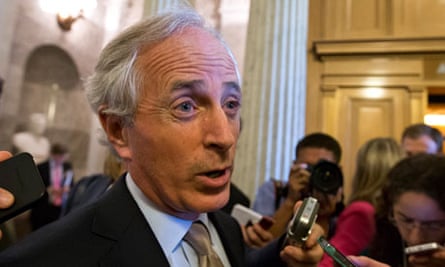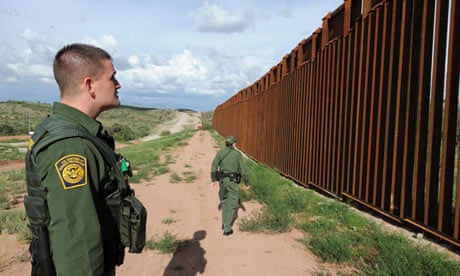The US Congress is planning a dramatic expansion of surveillance measures along the border with Mexico including round-the-clock use of unmanned aerial drones and radar systems developed by the military in Afghanistan as part of the package of comprehensive immigration reform.
The immigration reform bill currently being debated in the US Senate sets aside up to $6bn over five years to pay for a massive injection of surveillance technology along the south-western border. That includes $1bn to develop a new fool-proof social security card and other proposals to expand federal access to databases storing biometric and photographic records on American citizens and undocumented immigrants alike.
A new amendment by Republican senators John Hoeven of North Dakota and Bob Corker of Tennessee, that cleared a test vote in the Senate on Monday, calls for the US government to aim for a state of "persistent surveillance" along the border through an injection of surveillance technology that civil liberties groups fear could turn the border into a virtual military zone. The amendment, that is up for final senate approval on Wednesday, provides for the deployment of six "Vader" radar systems that were pioneered in Afghanistan as a way of tracking the planting of roadside bombs by the Taliban.
Vader, or Vehicle Dismount and Exploitation Radar, is a sophisticated airborne radar system that has already been tested along Arizona's border with Mexico mounted on Predator surveillance drones of the sort used by US forces in Iraq and Afghanistan. The Hoeven amendment is the first time that their use has been formally suggested for full deployment along the border.
Among the other innovations proposed by the amendment are handheld thermal imaging systems for detecting the movement of human bodies at night, seismic and infrared ground sensors and devices for detecting radioactive materials. The amendment calls for federal agencies to have the ability to conduct "continuous and integrated manned or unmanned, monitoring, sensing or surveillance of 100% of southern border mileage or the immediate vicinity of the southern border".
With the Senate debate focused around the issue of border security, supporters of the bill say the investments will provide a long-term solution to America's broken immigration system. The 11 million undocumented immigrants already in the country would be shown a pathway to citizenship, but only after the flow of new undocumented immigrants into the country has been staunched though a package of investments, including a proposal in the Hoeven amendment for a doubling of the number of US border patrol agents to almost 40,000.
But civil liberties groups and experts on biometric data fear that the focus on the border could have unintended consequences by spawning centralised databases storing details not just on undocumented individuals but on almost all US citizens. The American Civil Liberties Union points out that two-thirds of the US population lives within 100 miles of the country's land and coastal borders – within the remit of US border patrol.
"When we see such a large influx of federal money at the border, that's going to lead to a large influx of new surveillance techniques," said Chris Calabrese, the ACLU's legislative counsel on privacy-related issues. "There's a logic to all this – to find the people who are undocumented, you have to surveil the general population."

The senate bill, S 744, allocates $1bn in the 2014 budget to develop "fraud-resistant, tamper-resistant, wear-resistant, and identity theft-resistant social security cards". The bill does not specify how those criteria will be met, but experts in identity technology point out that in previous debates Congress has focused on the use of biometric data such as digital photos, fingerprints and iris scans.
Margaret Hu, a specialist in biometric digital surveillance at Duke university, said that the bill's ambition to create a fool-proof social security card posed dangers for the general public. "If it is used to create a universal and digitalised biometric database through the collection of digital photos, fingerprint or iris scans, this could be used as a cyber-surveillance tool that could significantly impact the lives of all Americans."
The bill uses the word "biometric" some 12 times. Section 3103, on "increasing security and integrity of immigration documents", instructs the homeland security secretary to report to Congress within a year of the bill passing on "the feasibility, advantages, and disadvantages of including, in addition to a photograph, other biometric information on each employment authorisation document issued by the department".
The bill also envisages a rapid expansion of E-Verify, a computerised data network that allows employers to check whether job applicants are permitted to live and work in the country. At present, E-Verify operates as a pilot scheme with just 7% of employers volunteering to use it.
But the bill requires the system to be rolled out to all US employers within four years of the bill's enactment. As part of that growth, the Homeland Security Department is instructed to develop a new digital apparatus called a "photo tool" that allows employers to "match the photo on a covered identity document provided to the employer to a photo maintained by a US citizenship and immigration services database".
Margaret Hu believes that such a verification device could only work if the government were to create a digitalised biometric database. "It would need a universal photo database of all citizens and non-citizens present in the US. That would be historically unprecedented, and the cyber-surveillance consequences could be enormous."
US customs and border protection has already laid down plans to boost its surveillance technology in the attempt to erect a "virtual fence" capable of satisfying Republican concerns about the porous crossing. The agency currently operates 339 remote video surveillance systems – day and night cameras that are used to detect incursions and are controlled from border patrol stations miles away.
It also has more than 15,000 sensors on the ground and 851 thermal imaging devices to detect the movement of people in the border region. That will be beefed up by the end of the year by fixed towers positioned at the crossing to integrate the various forms of surveillance equipment.
Michael Friel, spokesperson for US customs and border protection, said the agency was deploying "proven, effective surveillance technology tailored to the operational requirements along the highest trafficked areas of the south-west border."
Most controversially, that includes a fleet of unmanned aircraft, or drones, that numbers just 10 at present but is likely to increase exponentially with the injection of federal funds. The bill envisions a fleet of drones sufficient in number to allow them to be deployed "for 24 hours per day and for seven days per week".
The importation of military technology developed in the war zone is no coincidence: as the Obama administration continues to reduce troop numbers in Afghanistan, military contractors and arms manufacturers are increasingly looking for a new market to exploit, and the large sums Congress is considering pumping into border security provides an obvious alternative.
"We are at the tip of the iceberg here," said Mary Cummings, professor of aeronautics and astronautics at the Massachusetts Institute of Technology. "They don't have total coverage of the southern border with unmanned vehicles, but they could and I suspect they will. It's going to change the way that customs operates, though I don't think they realise that yet."
Laura Murphy, director of the ACLU's Washington legislative office, said: "This is so expansive. We are really talking about a militarisation of the border on a scale that we have never seen before."

Comments (…)
Sign in or create your Guardian account to join the discussion